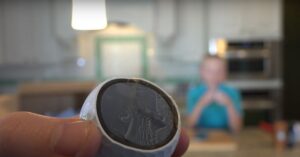What Are Golf Balls Made Off? [A Material Breakdown]
Golf is a popular sport enjoyed by millions around the world, and the key equipment in this game is the golf ball. Have you ever wondered what golf balls are made of?
Golf balls are typically composed of a combination of materials like synthetic rubber, plastic, and Surlyn or urethane coverings. These materials are significant and vital in optimizing golf ball performance by influencing factors like distance, spin, and feel of the golf when struck upon impact.
In this blog post, we will explore the material breakdown of golf balls and shed light on the main components that contribute to their unique characteristics.
What Are Golf Balls Made Off?
Golf balls are typically made from a combination of materials. The outer cover of a golf ball is usually made from either Surlyn or urethane. Surlyn is a synthetic resin material, while urethane is a type of thermoplastic elastomer.
- Outer Cover:
- Surlyn (a synthetic resin material)
- Urethane (a thermoplastic elastomer)
- Core:
- Solid rubber
- Synthetic rubber
- Intermediate Layers (in multi-layered balls):
- Synthetic rubber
- Blends of various materials (proprietary formulations)
Please note that this is a general list, and specific golf ball models may incorporate additional or alternative materials based on the manufacturer’s design and intended performance characteristics.
How Do The Materials Used In Golf Ball Construction Affect Durability?
![What Are Golf Balls Made Off? [A Material Breakdown] 1 image 27](https://giftedgolfers.com/wp-content/uploads/2023/06/image-27.png)
Choosing materials for golf ball construction is crucial in determining its durability.
Various factors come into play when considering the longevity of a golf ball, such as the cover material, core composition, and overall construction.
Cover Material
The cover material of a golf ball greatly impacts its durability. Most golf balls have either a surlyn or urethane cover.
Surlyn covers tend to be more durable and resistant to scuffs and scratches.
On the other hand, urethane covers offer a better feel and control but are generally less durable.
Core Composition
The core, or the innermost layer of a golf ball, also affects its durability. Solid rubber cores provide excellent durability, as they are resistant to cracking and deformation.
However, multi-layered cores with softer materials like liquid centers may sacrifice some durability for enhanced feel and distance.
Construction Design
The construction design of a golf ball influences its durability as well. Two-piece golf balls, consisting of a solid core and a cover, are known for their durability and distance.
They are less prone to damage on mishits. Multi-layered balls, while offering improved performance and feel, may be more susceptible to wear and tear due to their complex construction.
Compression
The compression rating of a golf ball can affect its durability. Higher compression balls tend to be more durable, as they are designed to withstand higher swing speeds and impact forces.
Lower compression balls, while offering a softer feel, may be more prone to damage and scuffing.
Environmental Factors
Lastly, environmental conditions can impact the durability of golf balls. Extreme heat or cold, as well as exposure to water and moisture, can affect the materials used in golf ball construction.
Storing golf balls in appropriate conditions and avoiding prolonged exposure to harsh elements can help maintain their durability.
Types Of Golf Ball Construction Two-Piece, Three-Piece, And More
![What Are Golf Balls Made Off? [A Material Breakdown] 2 image 28](https://giftedgolfers.com/wp-content/uploads/2023/06/image-28.png)
Certainly! In the world of golf, there are various types of golf ball constructions available.
The most common types are two-piece, three-piece, and multi-layered golf balls. Let’s explore each of them.
Two-Piece Golf Balls
These golf balls are the most popular and widely used among golfers. They consist of a solid rubber core surrounded by a durable cover made of surlyn or urethane.
The core is designed to provide maximum distance, while the cover offers durability and a soft feel.
Two-piece golf balls are known for their low spin rates, making them ideal for players who want to achieve long, straight shots.
Three-Piece Golf Balls
As the name suggests, three-piece golf balls have an additional layer between the core and the cover.
The core is usually made of solid or liquid rubber, while the second layer, known as the mantle, enhances spin control. The cover, similar to two-piece balls, is made of surlyn or urethane.
Three-piece golf balls offer a balance between distance and control, making them suitable for intermediate and advanced players who desire more spin and feel around the greens.
Multi-Layered Golf Balls
Multi-layered golf balls typically have four or five layers, including a solid or liquid rubber core, mantle layers, and a cover.
The additional layers provide enhanced performance and control for players with varying skill levels.
Each layer is designed to optimize specific characteristics such as distance, spin, and feel.
The outermost cover is usually made of urethane, which offers excellent control and greenside performance.
Multi-layered golf balls are commonly used by professional golfers and players seeking high-performance options.
Environmental Considerations: Sustainable Golf Ball Options
Reducing the environmental impact of golf is a growing concern for both players and course operators.
One area of focus is the development of sustainable golf balls that minimize harm to the environment. Here are some key considerations and options for sustainable golf balls
Recycled Materials
Using recycled materials in the production of golf balls helps reduce waste and conserve resources.
Many manufacturers now offer golf balls made from recycled materials such as rubber, plastics, and metals. These balls perform comparably to traditional ones while reducing the demand for virgin materials.
Biodegradable Golf Balls
Biodegradable golf balls are designed to break down naturally over time, reducing the accumulation of non-biodegradable waste on golf courses and in water bodies.
These balls are typically made from biodegradable polymers or natural materials that decompose without causing harm to the environment.
Water-Friendly Golf Balls
Water hazards on golf courses often accumulate large numbers of lost balls, which can have negative environmental impacts.
Water-friendly golf balls are designed to float, making them easier to retrieve and reducing the number of balls left behind.
These balls are often made from biodegradable materials to minimize their ecological footprint further.
Reduced Chemical Usage
Traditional golf balls are often manufactured using harsh chemicals that can be harmful to the environment.
Sustainable options aim to minimize the use of these chemicals, opting for greener alternatives in the manufacturing process. This reduces pollution and the potential for ecological damage.
Natural and Organic Materials
Another sustainable approach is the use of natural and organic materials in golf ball construction.
Manufacturers are experimenting with materials like bamboo, cork, and biopolymers derived from renewable resources.
These materials have a lower environmental impact throughout their lifecycle and can be recycled or composted after use.
Longevity and Durability
Promoting the longevity and durability of golf balls can also contribute to sustainability.
Balls designed to withstand multiple rounds of play reduce the need for frequent replacements, thereby reducing waste.
High-quality materials and construction techniques can ensure that golf balls maintain their performance characteristics over an extended period.
Frequently Asked Question
Golf balls are an essential component of the game, but have you ever wondered what they’re made of? In this material breakdown, we’ll explore the key components of golf balls and provide quick, clear answers to your burning questions.
What Is the Core of a Golf Ball Made Of?
The core of a golf ball is typically made of a solid or liquid rubber compound designed to provide the ball with its initial velocity and distance when struck by a club.
What Is the Cover of a Golf Ball Made Of?
The cover of a golf ball is commonly made of a durable material like Surlyn or urethane. These materials offer a balance of distance, spin control, and durability, ensuring the ball performs well and maintains its shape during play.
What Is the Purpose of the Dimples on a Golf Ball?
The dimples on a golf ball serve a crucial purpose by creating turbulence in the air as the ball flies. This turbulence reduces drag, allowing the ball to travel farther and more accurately.
Are There Different Types of Golf Ball Constructions?
Yes, golf balls come in various constructions to suit different players’ needs. The most common types are two-piece, three-piece, and multi-layered balls, each offering different characteristics in terms of distance, spin, and feel.
Can the Materials Use in Golf Balls Affect Performance?
Absolutely! The choice of materials in golf balls significantly impacts their performance. Different materials can influence factors like spin rates, feel, durability, and overall ball flight characteristics. It’s essential to consider these factors when selecting a golf ball that suits your playing style.
Conclusion
Golf balls are crafted from a variety of materials.
The outer cover is typically made of durable polymers, while the inner core consists of synthetic rubber or a combination of rubber and liquid compounds.
These materials ensure durability, distance, and control for golfers of all levels. Improve your game with the right golf ball!





